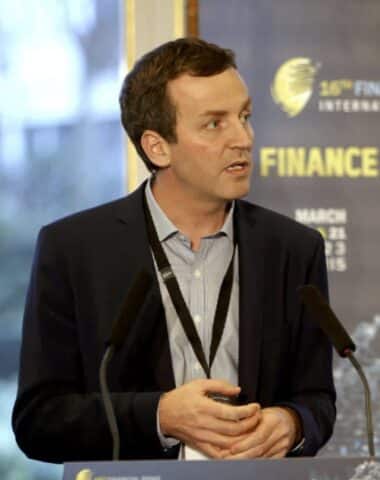Black-Scholes: the formula at the origin of Wall Street
- 50 years ago, Fischer Black and Myron Scholes described a method for determining the fair price of a call option.
- The Black-Scholes formula, based on the principle of dynamic replication, made it possible to control the risks of option trading and thus encouraged the development of derivatives markets.
- Today, options trading is still based on Black and Scholes' principle of dynamic hedging, and their formula, although no longer used directly, provides a common language for expressing more complex ideas.
- The French mathematical community played a key role in the development of financial mathematics
- Excellent training in mathematics and close links with the industry enabled the French grandes écoles and universities to create the first 'quant' courses, which are still a mark of excellence in the field.
This year marks the 50th anniversary of the publication of a landmark paper: “The Pricing of Options and Corporate Liabilities” by Fischer Black and Myron Scholes. This paper describes a method to determine the price of a call option, a financial contract which gives its holder the right (but not the obligation) to purchase a financial asset, called the underlying asset, at a predetermined price, at a predetermined future date. For all its importance, the formula itself is not the key contribution of the paper, as some versions of it were known well before Black and Scholes, notably from the 1900 thesis of Louis Bachelier “Théorie de la Spéculation”. The primary contribution is the method Black and Scholes used to prove that the formula is true.
To grasp their idea, think about a call option. Its price should clearly depend on the price of the underlying asset: when the price of the asset is high, the price of the associated option should also be high, and similarly, when the price of the asset is low, the option price should also be low. As time goes on and the asset price fluctuates, the option price will also fluctuate. It should then be possible, by purchasing the assets dynamically, to build a portfolio whose value will fluctuate in exactly the same way as the price of the option. Therefore, if a trader has sold the option and holds this dynamic portfolio, their position will be unaffected by market fluctuations, making it essentially risk-free.
As Black-Scholes theory became more widespread, options could be traded with greater certainty, without taking on too much risk.
This is where the pivotal idea of Black and Scholes comes into play: if the position is risk-free, the return on this position should be equal to the return of the risk-free asset, such as an interest-bearing bond. The concept behind this idea is called ‘absence of arbitrage’. If the return of the trader’s risk-free position were different from the interest rate, the trader could earn money without taking any risk and get very rich very quickly. Recognizing that the return of the hedged portfolio is equal to the rate of interest, Black and Scholes then derived an equation for the option’s price, whose solution is given by the Black-Scholes formula.
The key significance of the Black and Scholes approach is that behind their formula there is a strategy for hedging the option: a trader selling an option at the price given by the BS formula can immediately put in place a strategy, allowing to minimize, if not completely eliminate, the risk associated to this position. Prior to Black and Scholes, such dynamic hedging strategies could not be computed in a systematic way, which slowed down the development of derivatives markets.
Past and future of Black-Scholes formula
As Black and Scholes theory became widely known, options could be traded with greater security, without taking too much risk. This led to expansion of option trading, and the establishment of option markets, including the Chicago Board of Options Exchange (1973), Marché des Options Négociables de Paris (1987) and others.
The Black-Scholes formula had a turbulent youth. The first wake-up call came with the 1987 financial crisis. One key assumption behind the formula is that the asset price follows a « continuous time random walk ». This implies that the likelihood of having a large move over a short period of time, such as as single day, is very small. Nevertheless, on Monday, October 19, 1987, famously known as the Black Monday, Dow Jones Industrial Average (the main index of the American economy at that time) fell 22.6 per cent. Sellers of put options, designed to offer protection against such crashes, suffered heavy losses. It became clear that while the Black-Scholes formula performed well in normal market conditions, it failed to account for extreme events such as the Black Monday.
The answer of the financial markets was to adjust the parameters of the formula: the options offering protection against market crashes were now priced with higher volatility parameter than the options capturing small everyday market moves. This effect became known as the ‘volatility smile’ because of the smile-like shape the volatility graph has on traders’ screens. Since then, ever more complex extensions of the Black-Scholes formula were developed: local volatility, stochastic volatility, rough volatility, etc.
The Black-Scholes paradigm was questioned by several authors who argue that radically different models are needed for better risk management, such as the ones based on fractals introduced by Benoit Mandelbrot. However, these models never took hold in the financial industry because they do not allow for effective hedging. Risk management in options markets is still based on the dynamic hedging principle pioneered by Black and Scholes, and their formula, although rarely used directly, still provides the traders with a common language to express more complex ideas.
Mathematics and finance
The Black-Scholes formula results from an equation, reminiscent of the so called « heat equation » in physics, which describes the propagation of heat in a solid body. It is therefore no surprise that the first « quants » came from the physics background. However, mathematicians soon realized that they, and not the physicists, had the perfect tools to develop the theory of option pricing. With the publication of two landmark papers by Harrison and Kreps in 1979 and Harrison and Pliska in 1982, it became clear, that the theory of stochastic calculus is tailor-made for describing the notions of arbitrage, dynamic hedging, and ultimately, option pricing. Stochastic calculus was invented by Japanese mathematician Kyosi Ito, and further developed by the French school of probability in Paris and in Strasbourg. No wonder then that many mathematicians found in the new financial formulas a perfect application terrain with stimulating research questions, curious students, and supportive industrial partners. As a result, a productive and enduring partnership formed between some parts of the mathematical community and the financial sector. Not only mathematicians helped the traders to evaluate options, but the financial sector was an important source of ideas, which led to the emergence of new branches of probability.
A productive and lasting partnership has been formed between part of the mathematical community and the financial sector.
Unfortunately, this lasting relationship led some traders to believe that the mathematics enabled them to perfectly price and hedge any kind of option, however sophisticated it may be. When the global financial crisis struck, some thought that the mathematicians were to blame, and that the mathematical models were the « weapons of mass destruction » that precipitated the crisis. In truth however, the crisis was not caused by too much mathematical research, but too little of it. The formula used by the banks to price Collateralized Debt Obligations, a financial derivative largely responsible for the crisis, was too simple for this purpose, and failed to account for many risks associated with these complex products.
The crisis brought about profound changes, not only in the financial industry but also in the financial mathematics. Instead of developing complex models for option pricing, the focus of research shifted to more robust approaches and to the management of new types of risk such as the risk of systemic failures of the financial system.
The French connection
During the late 1980s, Paris emerged as a prominent financial center with numerous banks and a fledging option market. It was also the home of some of the world’s leading experts in probability, stochastic calculus and stochastic control. On the other hand, the French higher education system with its Grandes Ecoles had a stong emphasis on comprehensive training in mathematics, and many students were keen to learn about new applications of this scientific discipline.
Paris in the late 1980s was therefore a fertile ground for further advancement of financial mathematics, creation of teaching programs in quantitative finance, and partnerships between universities and financial institutions. This new domain attracted the interest of the leading French probabilists, among them Nicole El Karoui, Hélyette Geman, Nicolas Bouleau, Damien Lamberton and Bernard Lapeyre.
In 1990, a financial mathematics track was created in the main master program in probability at Jussieu (now Sorbonne Université). This program primarily attracted students from the leading engineering schools such as Ecole Polytechnique and Ecole des Ponts, who were taught the Black-Scholes theory with a distinct French flavor of stochastic calculus. Around the same time, a course in financial mathematics was introduced in Ecole des Ponts, leading to the publication, in 1992, of « Calcul stochastique appliquée à la finance » by D. Lamberton and B. Lapeyre, the first book on this topic in France and among the earliest in the world. In 1997, Nicole El Karoui became professor at Ecole Polytechnique, and created the course « Méthodes stochastiques en finance » in the applied mathematics major.
In the 10 years before the subprime crisis, the number of students in these and other programs skyrocketed, to the point that in 2006 Le Monde reported that « one out of three quants in the world is French ». In the wake of the financial crisis, student enrollment declined to some extent, due to a temporary decrease in hiring by banks. Moreover, the focus of the teaching programs shifted from option pricing to risk management and regulation. Currently, the flow of French quants continues at a more moderate pace. Nonetheless, the program at Polytechnique and the historical master program in probability and finance, now jointly managed by Polytechnique and Sorbonne Université, still represent a mark of excellence in the field.















